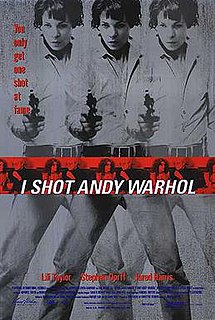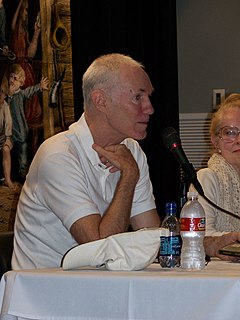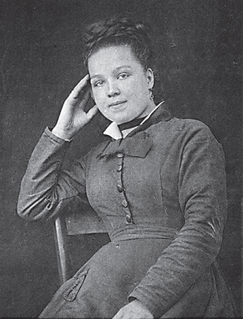
Desiderio Alberto Arnaz y de Acha III, better known as Desi Arnaz, was a Cuban-American actor, musician, bandleader, comedian and film, television producer and revolutionary in the creation of modern television. He is best known for his role as the witty Ricky Ricardo on the American television series sitcom I Love Lucy, where he co-starred with his then wife Lucille Ball. Arnaz and Ball are generally credited as the innovators of the syndicated rerun, which they pioneered with the I Love Lucy series.

Paul Benjamin Auster is an American writer and film director. His notable works include The New York Trilogy (1987), Moon Palace (1989), The Music of Chance (1990), The Book of Illusions (2002), The Brooklyn Follies (2005), Invisible (2009), Sunset Park (2010), Winter Journal (2012), and 4 3 2 1 (2017). His books have been translated into more than forty languages.

I Shot Andy Warhol is a 1996 American-British independent film about the life of Valerie Solanas and her relationship with the artist Andy Warhol. The film marked the feature film directorial debut of Canadian director Mary Harron. The film stars Lili Taylor as Valerie, Jared Harris as Andy Warhol, and Martha Plimpton as Valerie's friend Stevie. Stephen Dorff plays Warhol superstar Candy Darling. John Cale of The Velvet Underground wrote the film's score despite protests from former band member Lou Reed. Yo La Tengo plays an anonymous band that is somewhat reminiscent of the group.

Adam is a fictional character in the fourth season of the television series Buffy the Vampire Slayer. Portrayed by George Hertzberg, he is a monster created from a man and the collected parts of demons, vampires, and technology: the product of a perverse experiment carried out by military scientists. The series' main character, Buffy Summers, encounters and ultimately defeats him in the fourth season. Adam is the creation of Dr. Maggie Walsh, the head of a military-like organization called The Initiative that studies how to alter the harmful behavior inherent to demons. Adam and the Initiative are the fourth season's primary antagonists, or Big Bad.

Siri Hustvedt is an American novelist and essayist. Hustvedt is the author of a book of poetry, seven novels, two books of essays, and several works of non-fiction. Her books include: The Blindfold (1992), The Enchantment of Lily Dahl (1996), What I Loved (2003), for which she is best known, A Plea for Eros (2006), The Sorrows of an American (2008), The Shaking Woman or A History of My Nerves (2010), The Summer Without Men (2011), Living, Thinking, Looking (2012), The Blazing World (2014), and Memories of the Future (2019). What I Loved and The Summer Without Men were international bestsellers. Her work has been translated into over thirty languages.

Edmund Valentine White III is an American novelist, memoirist, and an essayist on literary and social topics. Much of his writing is on the theme of same-sex love. His books include The Joy of Gay Sex (1977), his trio of autobiographic novels, A Boy's Own Story (1982), The Beautiful Room Is Empty (1988) and The Farewell Symphony (1997), and his biography of Jean Genet.

Parade is a musical with a book by Alfred Uhry and music and lyrics by Jason Robert Brown. The musical is a dramatization of the 1913 trial and imprisonment, and 1915 lynching, of Jewish American Leo Frank in Georgia.

Andrew Holleran is the pseudonym of Eric Garber, an American novelist, essayist, and short story writer, born and partly raised in Aruba, in the Dutch Caribbean. He is a prominent novelist of post-Stonewall gay literature. He was a member of The Violet Quill, a gay writer's group that met briefly from 1980-81. The Violet Quill included other prolific gay writers like Edmund White and Felice Picano. Garber, who has historically been very protective of his privacy, uses "Andrew Holleran" as his pseudonym.
Lazlo Bane is an alternative rock band from Santa Monica, California, United States. They are well known for collaborating with former Men at Work member Colin Hay, and providing the song "Superman" as the theme for the television show Scrubs.

Kendall Hart is a fictional character from All My Children, an American soap opera on the ABC network. The character was portrayed by Sarah Michelle Gellar from March 11, 1993, to July 3, 1995, and by Alicia Minshew from January 2002 until the show's series finale on September 23, 2011. On March 7, 2013, it was announced that Minshew would guest star on the Prospect Park's continuation of All My Children. She appeared on the second July 8 episode, and exited the same day.

Elsa Hildegard Baroness von Freytag-Loringhoven was a German avant-garde, Dadaist artist and poet who worked for several years in Greenwich Village, New York.

House and Garden are a diptych of plays written by the English playwright Alan Ayckbourn, first performed in 1999. They are designed to be staged simultaneously, with the same cast in adjacent auditoria, and were published together as House & Garden. House takes place in the drawing room, and Garden in the grounds, of a large country house. Each play is self-contained, and they may be attended in either order. As is typical of his work, Ayckbourn portrays the mostly bittersweet relationships between more or less unhappy, upper-middle-class people. The title is a tongue-in-cheek reference to the magazine House & Garden, in which country houses and gardens are often portrayed as idyllic, peaceful places.

12 Days is a debut graphic novel/global manga written and illustrated by June Kim. Basing the plot partially on a story told to her by a stranger, Kim began an early version of 12 Days as a sophomore in college to help herself cope with the end of a relationship. After moving on emotionally with her break-up, she stopped developing the comic and later left South Korea to attend the School of Visual Arts in Manhattan, New York, United States, from which she graduated with a Bachelor of Fine Arts in cartooning. Following her successful pitch of 12 Days to manga publisher Tokyopop, she resumed work on it in early 2005 and finished in the middle of August 2006. 12 Days focuses on Jackie Yuen, who decides to drink the ashes of her former lover for twelve days in beverages as a way to cope with her grief over her death.

Prater Violet (1945) is Christopher Isherwood's fictional first person account of film-making. The Prater is a large park and amusement park in Vienna, a city important to characters in the novel for several reasons. Though Isherwood broke onto the literary scene as a novelist, he eventually worked in Hollywood as a screenwriter. In this novel, Isherwood comments on life, art, commercialization of art and Nazism.
Emily Byrd Starr is a fictional character created by Lucy Maud Montgomery and featured in the series of novels including Emily of New Moon, Emily Climbs, and Emily's Quest.

The Sorrows of an American is Siri Hustvedt's fourth novel. It was first published in 2008 and is about a Norwegian American family and their troubles. The novel is partly autobiographical in that Hustvedt herself is of Norwegian descent and in that passages from her own deceased father's journal about the Depression in America and the Pacific theatre of war during World War II are scattered through the book.

Owen Hunt, M.D. is a fictional character from the medical drama television series Grey's Anatomy, which airs on the American Broadcasting Company (ABC) in the United States. The character was created by series' producer Shonda Rhimes, and is portrayed by Scottish actor Kevin McKidd. He was introduced in season five as a U.S. Army trauma surgeon who served in war-torn Iraq, and subsequently joins the fictional Seattle Grace Hospital to teach medicine as a surgical attending, head of trauma surgery, and eventual chief of surgery, sometimes with unorthodox methods. Originally contracted to appear for a multi-episode story arc, he was upgraded to a series' regular at the conclusion of his first appearance.

The Cake Eaters is a 2007 American independent drama film about two small town families who must confront old issues with the return of one family's son. The film was directed by Mary Stuart Masterson and stars Kristen Stewart, Aaron Stanford, Bruce Dern, and Jayce Bartok. Kristen Stewart is featured as Georgia, a young girl with Friedreich's ataxia, a rare disease for which there is no cure.

Violet Evergarden is a Japanese light novel series written by Kana Akatsuki and illustrated by Akiko Takase. It won the grand prize in the fifth Kyoto Animation Award's novel category in 2014, the first ever work to win a grand prize in any of the three categories. Kyoto Animation published the first light novel on December 25, 2015, under their KA Esuma Bunko imprint. A 13-episode anime television series adaptation by Kyoto Animation aired between January and April 2018 with several advance screenings taking place in 2017. The series was awarded Best Animation at the 2019 Crunchyroll Anime Awards. An original video animation episode was released in July 2018, and a spin-off film premiered in Japan in September 2019. Another anime film was originally scheduled to premiere on April 24, 2020, but it was later delayed to September 18, 2020, due to the COVID-19 pandemic.

Louise Augustine Gleizes, known as Augustine or A, was a very famous woman in the late 19th century, due to neurologist Jean-Martin Charcot publicly exhibiting her symptoms as a hysteria patient while she was held at the Salpêtrière Hospital in Paris.


















